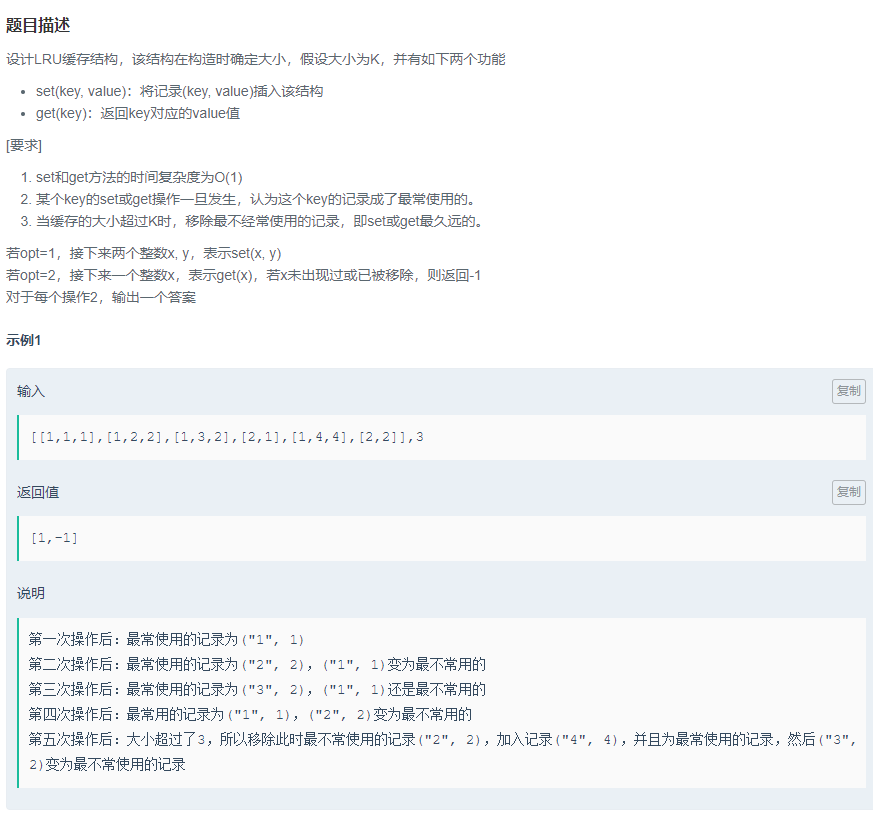本文最后更新于:2022年4月9日 中午
实现 LRU 缓存数据结构。
参考:牛客 - 设计 LRU 缓存结构 、力扣 - 146 LRU 缓存机制
哈希表 + 双向链表
双向链表按照被使用的顺序存储了这些键值对,靠近头部的键值对是最近使用的,而靠近尾部的键值对是最久未使用的。
哈希表即为普通的哈希映射(HashMap),通过缓存数据的键映射到其在双向链表中的位置。
1 2 3 4 5 6 7 8 9 10 11 12 13 14 15 16 17 18 19 20 21 22 23 24 25 26 27 28 29 30 31 32 33 34 35 36 37 38 39 40 41 42 43 44 45 46 47 48 49 50 51 52 53 54 55 56 57 58 59 60 61 62 63 64 65 66 67 68 69 70 71 72 73 74 75 76 77 78 79 80 81 82 83 84 85 86 87 88 89 90 91 92 93 94 95 96 97 98 99 100 101 102 103 104 struct DListNode {int key, val;int k, int v) : key(k), val(v), pre(nullptr ), next(nullptr ) {}class Solution {private :int capacity = 0 ;int size = 0 ;unordered_map <int , DListNode*> mp; public :int get (int key) int ret = -1 ;if (mp.find(key) != mp.end()) {return ret;void set (int key, int val) if (mp.find(key) == mp.end()) {new DListNode(key, val);if (size > capacity) {delete delNode;else {void addToHead (DListNode* node) void removeNode (DListNode* node) void moveToHead (DListNode* node) DListNode* removeTail () {return node;vector <int > LRU (vector <vector <int > >& operators, int k) if (k < 1 ) return {};this ->capacity = k;this ->head = new DListNode(0 ,0 );this ->tail = new DListNode(0 ,0 );this ->head->next = this ->tail;this ->tail->pre = this ->head;if (operators.size() == 0 ) return {};vector <int > res;for (auto & op : operators) {if (op[0 ] == 1 ) {set (op[1 ], op[2 ]);else if (op[0 ] == 2 ) {int value = get(op[1 ]);return res;
纯 LRU 算法
1 2 3 4 5 6 7 8 9 10 11 12 13 14 15 16 17 18 19 20 21 22 23 24 25 26 27 28 29 30 31 32 33 34 35 36 37 38 39 40 41 42 class LRUCache {list <pair <int , int >> cache;unordered_map <int , list <pair <int , int >>::iterator> map ;int cap;public :int capacity) {int get (int key) if (map .count(key) > 0 ){auto temp = *map [key];map [key]);map .erase(key);map [key] = cache.begin();return temp.second;return -1 ;void put (int key, int value) if (map .count(key) > 0 ){map [key]);map .erase(key);else if (cap == cache.size()){auto temp = cache.back();map .erase(temp.first);pair <int , int >(key, value));map [key] = cache.begin();

